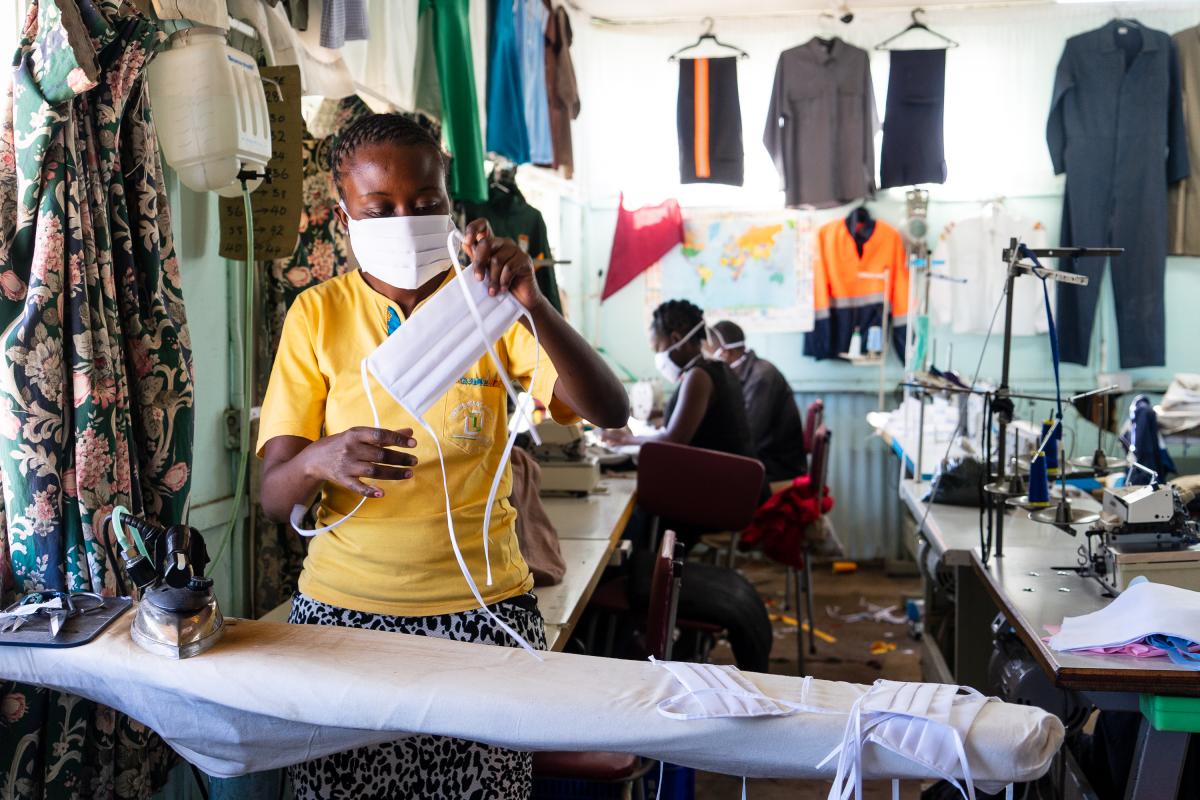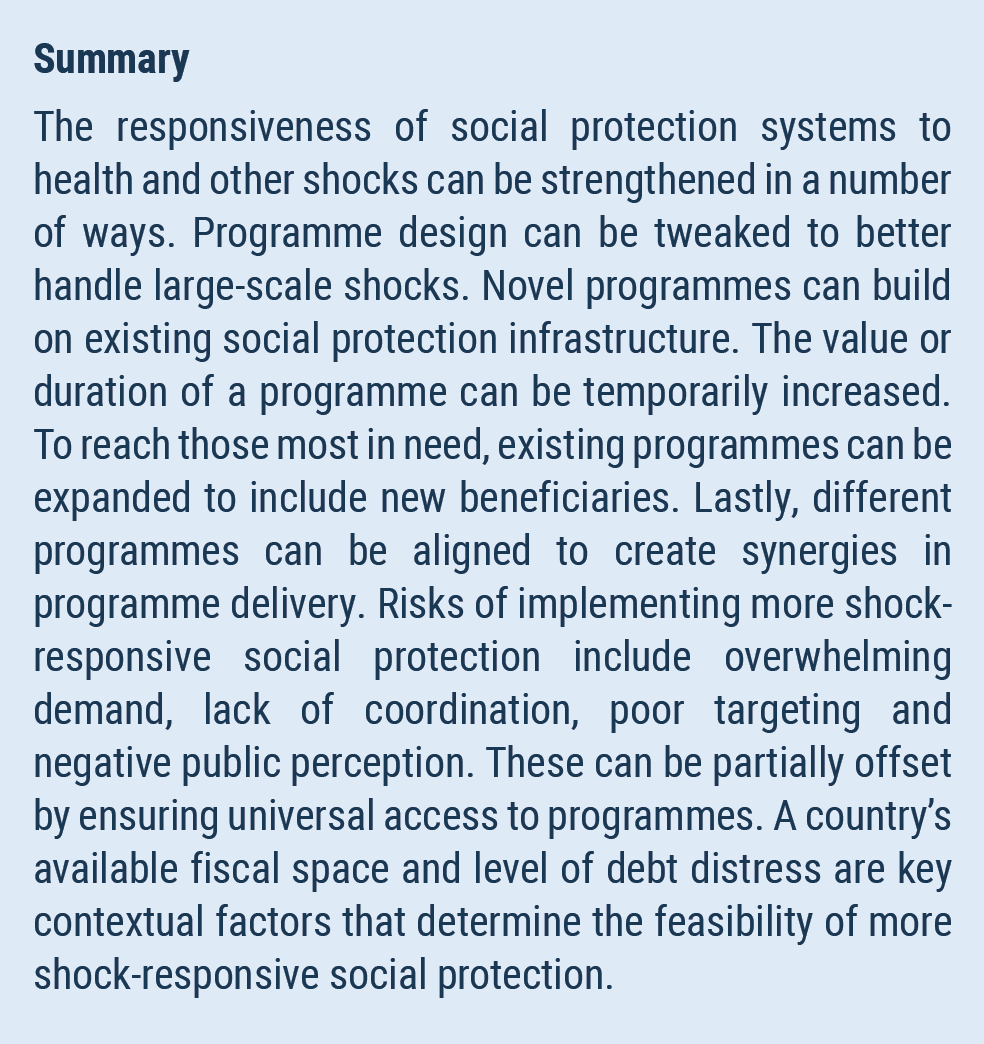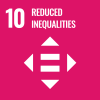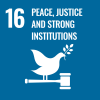
 Introduction
Introduction
Social protection systems play a key role in preventing hardship when people face adverse circumstances. Many countries around the world have some social protection programmes in place. In 2017, 45 per cent of the global population were covered by at least one social protection programme (ILO, 2017). However, COVID-19 is testing the limits of these systems. Unprecedented numbers of people are suddenly facing unemployment, disease, poverty and hunger. This brief explores how social protection systems can be made to be more responsive to acute shocks and enable countries to recover better. Well-designed systems should be both resilient enough to withstand the shock and flexible enough to adapt to rapidly changing circumstances and needs.
Shock-responsive social protection systems
All social protection systems are designed to respond to shocks since, in addition to addressing chronic conditions, they are meant to address acute events that negatively impact individuals and households. However, some systems respond better than others. Typical life cycle events, related to the loss of jobs or illness, usually only affect some households at the same time. Standard social protection systems are set to respond to these individual or household-level shocks. A shock-responsive social protection system is also prepared to respond to covariate or systemic shocks that affect a large number of households simultaneously—be they natural disasters, food shortages, economic crises or disease outbreaks such as COVID-19. It is a system that can cope with sudden changes in both context and demand. Covariate shocks can be natural, political, or economic in nature.
Building more shock-responsive social protection systems
When faced with a sudden shock, it is vital that social protection systems balance adequacy, coverage and comprehensiveness. Affected individuals and households must be able to access adequate benefits quickly, without excessive administrative requirements. In response to the socioeconomic impacts of COVID-19, a majority of countries have rolled out emergency measures to support their citizens. The pandemic is pushing existing social protection programmes to the brink, with demand far beyond usual operating capacity. To build back better, now and in the future, governments should take this opportunity to review and strengthen the shock-responsiveness of their social protections systems.
The following five main measures can improve the shock responsiveness of social protection systems (O’Brein and others, 2018):
1. The design of social protection programmes can be tweaked to optimize the response to typical crises faced by a country. This builds a certain degree of flexibility into programmes in case of a shock and allows a Government to maintain service delivery when it is needed most. For example, in an earthquake prone region, it might be prudent to temporarily waive a pro-gramme’s school attendance conditionality in case of an earthquake. Additionally, a protocol could be put in place that enables people to receive cash transfers over the counter in case the regular electronic payment system is temporarily disabled.
2. A novel response to a shock can be delivered by taking advantage of the existing social protection infra-structure (also known as “piggybacking”). Examples are borrowing a list of beneficiaries or a payment mechanism from an existing programme to deliver new benefits. Importantly, delivery can fall on actors that are outside of the existing programme and can even include non-governmental actors.
3. The value or duration of a benefit can be temporarily increased in response to a shock (vertical expansion). An example is the temporary increase of the Canada Child Benefit in response to the COVID-19 outbreak. The Government of Canada has increased the benefit by up to 300 Canadian dollars per child, resulting in a benefit increase of about 550 for the average family (Government of Canada, 2020).
4. The coverage of existing social protection pro-grammes can be temporarily expanded to new beneficiaries (horizontal expansion). This can be accomplished by expanding a programme’s geographical coverage or by adjusting eligibility criteria. An example is the adjustment of eligibility rules for the short-term work (Kurzarbeit) subsidy in Germany. Among other adjustments, the programme has been extended to temporary workers and the eligibility threshold of affected employees has been reduced to 10 per cent from 33 per cent in response to the COVID-19 crisis (Bundesministerium der Finanzen, 2020).
5. The alignment between different programmes can be improved to create synergies in delivery. This can in-crease efficiency by, for example, letting multiple pro-grammes use the same delivery mechanism, targeting methodology or transfer schedule.
Risks
Covariate shocks pose challenges to any social protection system. There are several important risks to be kept in mind. First, systems can be overwhelmed by a potential increase in demand an order of magnitude greater than their normal operating capacity. Second, when coordination is poor, there might be confusion about programme objectives between actors. If multiple agencies attempt to piggyback on the same system, there is again the risk of overwhelming the underlying system.
Third, people at risk may be missed despite pro-gramme expansion. This is particularly the case for vertical expansion, with the temporarily increased value of a benefit not reaching the people most affected by the shock because they do not qualify for the programme in the first place. In Sub-Saharan Africa, for example, only 13 per cent of the population is covered by at least one social protection programme (ILO, 2017). The risk of excluding potential beneficiaries is certainly higher when social protection measures are narrowly targeted. Accurate target-ing is very challenging and requires strong administrative capacities. The risk of failing to reach potential beneficiaries is often higher than the risk of including people who are not entitled to benefits. A more inclusive approach to programme design, such as introducing a universal social protection floor, would lower this risk.
Finally, expanding programmes, even if temporarily, risks diluting the programme’s original objectives, may create confusion among existing beneficiaries and could negatively impact the public perception of the programme. To minimize this risk expansions should be clearly defined, actively communicated to the public and financially transparent. Moreover, promoting universal social protection to enable the inclusion of all can help mitigate this risk altogether and is an essential part of achieving the 2030 Agenda for Sustainable Development (UN, 2018).
Contextual factors
An important element to consider is the political context in which a social protection system is embedded. The political will to implement more shock-responsive social protection will differ strongly both within and between countries. Laws and regulations relating to social protection systems are also far from uniform. Furthermore, countries have different levels of organizational capacity. Shocks can amplify existing organizational weaknesses as demand surges and availability of staff (and volunteers) could be constrained when they themselves are affected by the shock. In some contexts, it might be difficult to provide adequate capacity even under the best of circumstances.
In the context of the current pandemic, weaknesses in the social protection system of any one country can en-danger the entire international community. Namely, when social protection systems fail to cover certain groups of workers, including those in the informal economy, many such workers must keep going to work to maintain an in-come – encouraging behavior that could further spread the virus, including across borders. Hence, it is essential to assert the global political will to implement appropriate social protection systems for all (SDG 1.3) and provide international support where needed to build back better.
Additionally, it might prove difficult to find sufficient fiscal space to implement more shock-responsive social protection systems, particularly in developing countries. Not all countries are able to maintain contingency funds or, as a temporary emergency measure, turn to international capital markets, for example. Over the last decades, many developing countries have been able to avoid the “pro-cyclicality” trap and increase expenditure during bad times. However, about 60 per cent of them still relied on procyclical spending during the 2009-2016 post-global recession period (Herrera, Kouame and Man-don, 2019). Procyclical fiscal spending amplifies negative economic shocks by cutting spending precisely when additional spending is needed most.
Large-scale shocks, by their nature, have a significant impact on the social and economic fabric of a country. Governments may face a reduction in tax revenue precisely when the need from households is greatest. The current COVID-19 crisis serves as an extreme example. The United States of America alone is projected to face a federal budget deficit of $3.7 trillion (about 18 per cent of GDP) for the fiscal year 2020 compared to a projected baseline deficit of $1 trillion before the crisis (Congressional Budget Office, 2020). This significant increase in the projected deficit is a result of both reduced tax revenue and increased public spending. Deficits of this magnitude are unprecedented during peacetime. Few developing countries will be able to run deficits of this size without severe financial repercussions. To avoid running unsustainable deficits, countries can consider reviewing current budget allocations and reprioritizing expenditure.
Several options exist to ensure countries have ac-cess to sufficient and timely funding during a crisis. The first is to create a contingency fund. This domestic fund could then be called upon relatively quickly during an emergency, provided it is maintained and adequately managed. Such funds could also be pooled regionally, or even globally, to reduce operating costs through scale and simplify emergency response. Second, disaster insurance can ensure Governments have access to immediate fund-ing after a certain predefined event occurs. Such a facility should be designed to provide an additional source of financing to help the world’s poorest countries respond to cross-border, large-scale disease outbreaks with clear triggers and rapid, commensurate payouts. Ideally such instruments should operate at a global level, to ensure sufficient diversification of risk. Additionally, it is critical for the international community to address debt in developing countries (United Nations, 2020). This includes providing debt relief measures and concessional or grant financing to free up the necessary fiscal space to create or maintain social protection systems that are more responsive to shocks.
The current crisis highlights the importance of financially sustainable social protection systems. In the medium- to long-term, sustainability will require broader tax bases, corporate-tax reforms that ensure multinationals contribute their fair share, progressive income and wealth taxes, as well as policies to reduce illicit financial flows.
Conclusion
Improving the shock responsiveness of social protection systems strengthens a Government’s ability to address major, systemic shocks. Rather than being forced to respond to a crisis with ad-hoc measures, policymakers can build shock preparedness into the system, as outlined in this brief. Doing so strengthens the role of social protection systems as automatic stabilizers and reduces the risk of a delayed response in the face of a crisis. In order to strengthen responsiveness, it is essential to ensure that sufficient funds are available when needed most.
Yet, it is important to acknowledge that no social protection system, however shock responsive and well designed, can prepare a country for every eventuality. Countries can only aim to better understand their risk profile, prepare for the most probable shocks and pro-mote universal social protection policies. There will al-ways be a need for supplementary policy measures in case disaster strikes.
COVID-19 has in many ways triggered an unprecedented global crisis, unique in both its scope and impact. However, it is unlikely to be the last shock the countries of the world will face. Whatever form the next crisis takes —whether a drought, hurricane, rise in food prices, political dispute, or global pandemic—it is crucial for countries to ensure that no one is left behind. Improving the shock-responsiveness of social protection systems is a crucial area for action in achieving this goal.
 Welcome to the United Nations
Welcome to the United Nations


